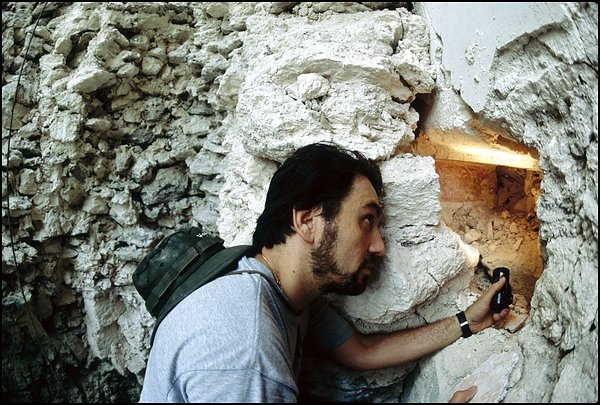 |
|
in Guatemala called Cival, where his team found this limestone mask, right. |
Maya Artifacts Found in Guatemala
 |
|
in Guatemala called Cival, where his team found this limestone mask, right. |
Society's Rituals May Have Evolved Earlier Than Thought
By Guy Gugliotta
Washington Post Staff Writer
Archaeologists working in a remote stretch of Guatemala's northeastern Peten wilderness said yesterday they have unearthed evidence that the ancient Maya may have developed sophisticated rituals and institutions hundreds of years earlier than previously thought.
The city of Cival -- five pyramids and three plazas overgrown with tropical greenery -- yielded a cache of ritual jade artifacts that are about 2,500 years old, two huge carved and painted masks, and an inscribed stone slab unlike anything ever found in the region.
The city's monumental structures are built on an axis pointing toward the rising sun of the autumnal equinox and evolved over several centuries to give the elites better opportunities to view the ceremonies, the researchers said.
"We are witnessing the development of dynastic rituals," said Vanderbilt University archaeologist Francisco Estrada-Belli, leader of the Cival excavation team. "It is unusually early, especially for the eastern Peten."
Maya civilization flourished in large areas of Central America for 3,500 years, ending with the Spanish conquest, but its apogee, known as the "classic" period, is regarded as having lasted from about A.D. 200 to A.D. 800.
Many well-known classic Maya sites are in the tropical forest of the eastern Peten, but before Cival, archaeologists had not found extensive "pre-classic" sites there. Estrada-Belli said the site, about 20 miles from the border of Belize, was occupied from about 500 B.C. to A.D. 100.
"It's an incredible site," said archaeologist Richard Hansen, excavator of El Mirador, in central Guatemala, a famous pre-classic Maya site. "All of a sudden we have this interesting cluster, and it's earlier than anything else in the area."
Estrada-Belli said in a telephone interview that Cival had been discovered and sketchily mapped in the 1980s, but that formal excavation did not begin until his team reached the site in 2001. Estrada-Belli presented his findings yesterday at the National Geographic Society, one of the research sponsors.
Estrada-Belli said his surveys showed that the site was about a half-mile square, twice as big as first thought, and may have had 10,000 inhabitants at one time. "This was a big city," Estrada-Belli said. "It must have been the early capital of the region."
The main plaza was flanked by a pyramid on the west and a flat platform on the east, originally designed to allow townspeople standing on the platform an unrestricted view of the rising sun at the autumnal equinox -- around Sept. 25.
Later, however, the Maya built a much larger pyramid -- 108 feet tall -- beyond the platform, blocking the townspeople's sightline but offering the elites a much better view from the summit. Archaeologists regard this architectural arrangement, known at many classic Maya sites, as an indication of a developing class structure and greater ritual sophistication.
"He's coming up with Maya state institutions at a much earlier time," said Mesoamerican archaeologist Elsa Redmond of the American Museum of Natural History in New York. "These buildings show us what is basically a rulers' ideology."
Although Estrada-Belli's team members were Cival's first formal excavators, looters had already invaded the site, cutting tunnels into the large pyramid and through the platform to the plaza.
Walking into the pyramid trench, Estrada-Belli spotted a "few inches of what looked like a sculpture." It turned out to be a 15-foot-wide, 10-foot-tall mask of a human face with L-shaped eyes adorned with corn husks and a square mouth with snake fangs.
Estrada-Belli described the mask -- limestone covered with a thick coat of stucco painted red and black -- as a "corn deity" dating to 150 B.C. Later, the team found an identical mask on the other side of what appears to be a staircase.
Out in the plaza, a second looter's tunnel led to the stone slab, dated at 300 B.C. -- perhaps the oldest "stela" of its kind ever found in the Maya lowlands. Below the stela was a cross-shaped depression containing five smashed ceramic jars, 120 pieces of polished jade and five jade axes, each 10 inches long and strongly suggestive of the contemporary Olmec culture of southern Mexico. Estrada-Belli dated the cache to 500 B.C.
Despite the signs of foreign influences, Redmond said the long, decidedly Maya history of Cival tends to disprove the theory that the eastern lowlands were colonized around A.D. 200 by invaders -- perhaps from the Mexican plateau.
Cival shows that "Maya institutions and civilization go way back," she said. Foreigners may have come "through trade," she added, or through "early classic politics -- the political marriage alliance."
© 2004